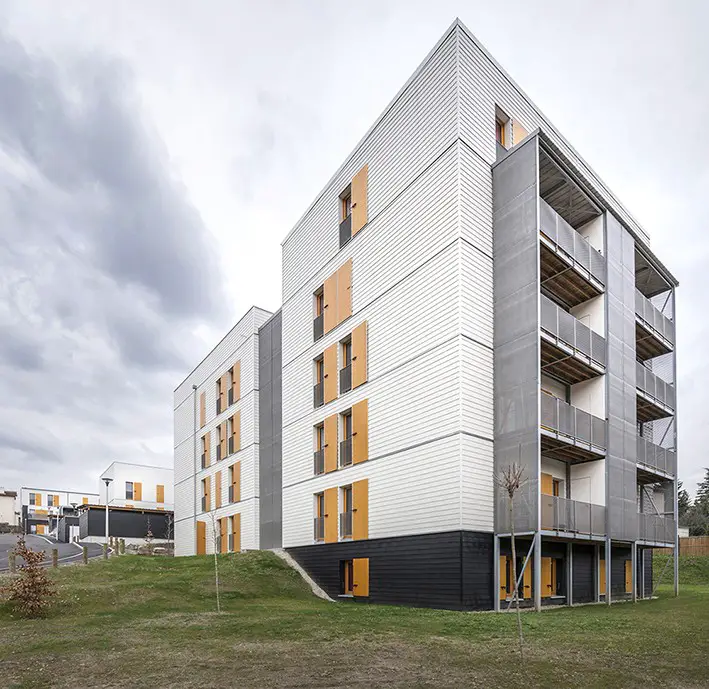Architectural Energy Depletion, Why House Building should be limited or prevented in the UK in 2016, Architecture Resources, Materials
Architectural Energy Depletion Architecture Resources: Why UK House Building should be limited
British Homes Construction – Sustainability versus Need: Architecture Discussion by Ian K Whittaker
9 Jun 2016
Why House Building should be limited or prevented in the UK in 2016
Architectural Energy Depletion Architecture Resources Article by Ian K Whittaker
Why House Building should be limited or prevented in the UK in 2016
Premise
The construction of a house in the UK is inherently depleting in terms of environment, energy, and resources.
Construction of houses should be limited or prevented to allow adaptation to the effects of the current context of a century of climate change, depleting fossil fuel use and depleting energy, resource and environment humans are having to adapt to.
Background
This analysis examines the construction of a 3 bedroom, 2 st, house as built in the UK in terms of the Incentives, Population, Existing Housing Numbers, Environment, Climate Change, People, Plant, Energy, Resources, Time and Lifespan required to produce it.
Incentive
A house provides economic value, employment, skills, knowledge, incentives, occupations, need, value, quality, appreciations of beauty, culture and society.
One house involves over 1000 people during its construction.
To allow these 1000 people to be available however a national depletion economy, assisting in the driving of climate change by outputting carbon emissions is needed.
Population – Numbers
In 2016 the Population in the UK was approx. 64,088,222 (July 2015 est) [1]
If the UK Population is extrapolated up to 2050 then it will reach approx. 75,361,000 [2]
The UK population will increase and so it appears more houses will be needed.
If the need for more homes is tested against the existing housing provision then the true requirement for housing construction can be established.
Population – Existing Housing Numbers
In the UK in 2008 there were 26,473,000 households. [3]
In the 2011 census the most common form of house type, comprising 15,000,000 households, 42% of the housing stock, had 3 bedrooms and was owner occupied.
4,446,000 households, 19%, had more than 3 bedrooms. [4]
In relation to the previous population numbers this allows for 2.4 people per house hold with the current population and 2.8 people per house hold with the projected population in 2050.
3 Bedroom houses can accommodate up to 4 people.
Therefore there is no current need for any more houses to be constructed in the UK to meet increasing population numbers up to 2050 since 61% of the households can accommodate at least a 50 % increase in population and the current projected increase is only for 11,272,778 people, a 17% increase.
Environment
337 to 405 m2 of land area. 1/12th to 1/10th of an acre is needed to be provided per house.
This land area is not retrievable until the house and the supporting infrastructure are removed.
Climate Change
The emissions for constructing a single house can be considered in terms of weight of materials, construction sector emissions, emissions for 1 house and volume of emissions for 1 house.
Weight
If the tonnage of one UK house is estimated at approx. 90 to 100 tons then 1 house produces.
54,872 m3, 38m x 38m x 38m, cubic volume of Carbon Dioxide emissions.
Construction Sector Emissions.
The Total Carbon Dioxide Emissions 2014 excl. exports for the UK.
514.4 Mt CO2e [5]
‘The amount of CO2 emissions that construction can influence is significant, accounting for almost 47% of total CO2 emissions of the UK. ‘[6]
47% x 514.4 Mt CO2 Total Carbon Dioxide Emissions for the UK.
241.768 Mt CO2 Emissions for the whole construction industry in the UK.
Emissions for 1 house
The Total Number of houses started in 2014 – 2015 in all of UK.
333,700. [7]
The housing market accounted for 35% of the total construction sector output in 2015 [8]
35% x 241.768 Mt CO2 Emissions for the whole construction industry in the UK.
84 Mt CO2 Emissions for the total housing sector in the UK in 2014-2015.
333,700 / 84 Mt CO2.
3972 Mt CO2 Emissions for 1 UK house in 2014-2015.
Volume of Emissions for 1 House.
Volume of one ton CO2
22730 moles × 24.47L/mole
556200L
556.2m³ volume of one ton CO2
3972 Mt CO2 emissions x 556.2m³ per ton of CO2.
2,209,226 m3 volume of Carbon Dioxide Emission for 1 house in the UK.
This equates to a cube of approx. 130m x 130m x 130m of Carbon Dioxide emissions for each house constructed in the UK.
A single house is therefore a significant driver of climate change.
People
The number of individuals and businesses within the construction industry can be calculated by allowing for 280,000 businesses covering some 2,930,000 jobs to provide for an average of 10 people per business. [9]
Over 1000 people over 1 to 2 years of construction time are required to allow all land purchase, financing, conveying, design, approvals, construction, suppliers, manufacturers, utilities, plant hire, tool hire, trades and professions to be carried out to allow the house to be constructed.
Plant
Each of the following plant need the whole UK economy operating before they can be resourced, designed, manufactured and transported and used to construct 1 house.
At least 1 JCB excavator
At least 3 skip vehicles
At least 1 dumper truck
At least 2 concrete mixing vehicles.
2 temporary port cabin units
At least 5 low loader delivery vehicles
2 Transformer units
Energy
The energy required to construct 1 house can be calculated.
Energy – The UK Economy
Allowing for the whole population of 64,000,000.
Allowing for the UK Oil consumption (2013 est) to be 1,217,000 barrels per day [10]
64,000,000 / 1,217,000 barrels.
52 barrels of oil consumed per head of population per day.
Energy – The Construction Sector
Allowing for the construction industry to cover 10% of all UK employment. [11]
Allowing for the construction industry to employ 2,930,000 people. [9]
2,930,000 / 1,217,000 barrels.
2.4 barrels of oil consumed per day per head of population for the construction industry.
Energy – The Workforce in the Construction Sector
Allowing for 1000 people to construct a 3 bed 2st house in the UK.
1000 x 2.4 barrels of oil consumed per day per head of population for the construction industry.
2400 barrels of oil consumed per day for these 1000 people.
Over the 2 year construction period for 1 house.
365 x 2
730 days
730 days x 2400 barrels of oil consumed per day for these 1000 people.
1,752,000 barrels of oil consumed for these 1000 people to build a house over 2 years.
Approx. 2,852,606,400 kWh
Energy – Operating the House
To operate a 3 bed 2st house in the UK for a year requires.
4,115 kWh per year. Equal to 2.4 barrels of oil per year. [12]
Fossil fuels are needed for currently 71.1% of the total installed capacity (2014 est.) for generating electricity in the UK [13]
Fossil fuels are therefore one of the main components of the construction and operation of every house in the UK.
Resources
Only the major resources required to form the shell of a house are listed.
The house does contain other materials but these vary in type and extent.
All of the resources require the full UK economy to be in operation to allow them to be extracted, designed, manufactured and transported before being installed as part of a house.
25 trees.
30 cubic metres of reinforced concrete.
40 to 60 tons of bricks, blocks and sand.
100 rolls of insulation.
2000 roofing slates.
Timescales
To finance, design, construct and finally occupy a 3 bed 2st house in the UK requires.
1 year of obtaining finance.
1 year of design and approval.
1 to 2 years of construction time.
Total 4 years.
There are other timescale depletion factors caused by the construction of the house.
To replace the land 100 years.
To replace the trees 5 years.
Lifespan
The Lifespan for a 3 bed 2st house in the UK can be up to a hundred years.
Each year of existence adds to the depletion of resources, energy and environment.
Conclusions.
If considered in terms of forming economic value, employment, skills, knowledge, incentives, occupations, need, value, quality, appreciations of beauty, culture and society the construction of one house influences over 1000 people.
In relation to Population and Existing Housing Numbers there is no current need for any more houses to be constructed in the UK to meet population numbers up to 2050.
In terms of Environment the construction of 1 house is depleting for up to 100 years.
If considered in terms of release of Carbon Dioxide; the largest component of human influenced climate change; constructing a house is a significant driver of climate change.
If considered in terms of energy a single house requires up to 1,752,000 barrels of oil, Approx. 2,852,606,400 kWh to be constructed but only 2.4 barrels of oil per year approx. 4,115 kWh per year to operate. A construction to use ratio of approx. 693,221: 1
Fossil fuels are one of the main components of the construction and operation of every house in the UK. Fossil fuels are however; to assist in adapting to climate change; being phased out up to 2050.
The construction to use ratio indicates that a single house is extremely depleting but easy to build currently. It also indicates that constructing a single house and will become increasingly depleting and difficult to achieve in a post fossil fuel society.
If considered in terms of resources a single house is a depletion driver.
If considered in terms of timescale then all of the depletion factors must be doubled to allow for the financing design and approval stages of any house construction.
The construction of a house in the UK is therefore proven to be inherently depleting in terms of environment, energy, and resources.
Construction of houses should therefore be limited or prevented to allow adaptation to the effects of the current context of a century of climate change, depleting fossil fuel use and depleting energy, resource and environment humans are having to adapt to.
References
1.Source: CIA World Factbook
- Source: https://en.wikipedia.org/wiki/List_of_countries_by_future_population_(United_Nations,_medium_fertility_variant)
- Source: https://en.wikipedia.org/wiki/List_of_countries_by_number_of_households
- Source: http://webarchive.nationalarchives.gov.uk/20160105160709/http://www.ons.gov.uk/ons/rel/census/2011-census/detailed-characteristics-on-housing-for-local-authorities-in-england-and-wales/sty-households-in-england-and-wales.html
- Sources: Table 3, Final UK greenhouse gas emissions national statistics 1990-2014 Excel data tables
2014 UK greenhouse gas emissions: final figures – statistical release
- Source: BIS Estimating the amount of CO2 emissions that the construction industry can influence Supporting Material for the Low Carbon Construction IGT Report Autumn 2010
- Source: Table 208: permanent dwellings started, by tenure and country
- Source: BRIEFING PAPER Number 01432, 6 October 2015 Construction industry: statistics and policy
- Source:http://www.gov.uk/government/uploads/system/uploads/attachment_data/file/210060/bis-13-958-uk-construction-an-
economic-analysis-of-sector.pdf
- Source: https://en.wikipedia.org/wiki/List_of_countries_by_oil_consumption
- Source:http://www.gov.uk/government/uploads/system/uploads/attachment_data/file/210060/bis-13-958-uk-construction
an-economic-analysis-of-sector.pdf
- Source: http://www.gov.uk/government/uploads/system/uploads/attachment_data/file/449134/ECUK_Chapter_3_-_Domestic_factsheet.pdf” – Energy Consumption in the UK (2015) – Gov.uk
- CIA World Factbook UK
Ian K Whittaker
Article by Ian K Whittaker
Comments on this Architectural Energy Depletion Architecture Resources article are welcome.
English Housing Links
English Housing

photo : Paul Riddle
English Houses

photo from Polysolar
Ian K Whittaker Articles
Architecture Discussions by Ian K Whittaker on e-architect
Architectural Materials Depletion
Architectural Energy Depletion : Managing Transition
The Chemical Bio-Synthesis of Architecture
Marcus Vitruvius Pollio : Origins of the Architect
Architectural Articles Selection
Resisting Boredom : article by Joyce Hwang. 25 Jan 2011
Placebo Architecture : article by Karolina Szynalska – 27 Sep 2011
Architecture Narrative : article by Trevor Tucker. 24 Aug 2010
Nature Architecture : article by Trevor Tucker. 15 Sep 2009
Sustainable Buildings – Building Issues : article by Adrian Welch
Housing
Comments / photos for the Why House Building should be limited or prevented in the UK in 2016 – Architectural Energy Depletion Architecture Resources Article page welcome

